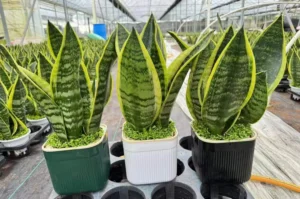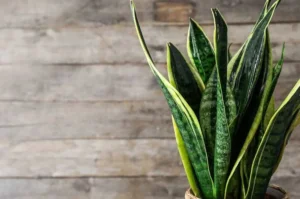Snake plants (Sansevieria) are popular indoor plants, but can they grow outside? The answer is yes! However, their survival depends on the climate and care.
Can Snake Plants Grow Outside?
Yes, snake plants can grow outside in warm climates (USDA zones 9-11). They thrive in partial shade to full sun, well-draining soil, and temperatures above 50°F (10°C). Protect them from frost and excessive rainfall.
Best Climate for Outdoor Snake Plants
Snake plants thrive in warm temperatures between 50-90°F (10-32°C). They do best in tropical and subtropical regions where winters are mild. If you live in a colder area, bring your plant inside when temperatures drop below 50°F (10°C) to prevent damage.
1- Sunlight Requirements
Snake plants can handle different light conditions. Outdoors, they prefer partial shade or indirect sunlight. Too much direct sun can scorch their leaves, while too little light can make them weak and leggy.
2- Soil and Drainage
Good drainage is key! Use well-draining soil, such as a mix of potting soil, sand, and perlite. Avoid heavy, clay-like soil that traps water, as snake plants don’t like wet roots.
3- Watering Needs
Snake plants need less water than many other plants. Water only when the soil is dry. Overwatering can lead to root rot, especially in humid climates. During rainy seasons, you may not need to water at all.
4- Protection from Cold
If temperatures drop, move your plant indoors or cover it with a cloth at night. Cold and frost can damage the leaves, turning them mushy and brown.
5- Pest Control
Outdoors, snake plants can attract pests like mealybugs and spider mites. Check the leaves regularly and wipe them with a damp cloth or mild soapy water if needed.
Can You Take a Snake Plant Outside?
Yes, you can take your snake plant outside, but ensure the conditions are suitable. Gradually introduce it to outdoor light to avoid shock, and choose a spot with indirect sunlight.
How to Care for a Snake Plant Outside
- Choose the right location: Partial shade with indirect sunlight.
- Use well-draining soil: A mix of potting soil, sand, and perlite works best.
- Water sparingly: Only when the soil is dry to prevent root rot.
- Monitor temperature: Bring indoors if it drops below 50°F (10°C).
- Check for pests: Regularly inspect and clean the leaves.
Benefits of Snake Plants
- Air purification: They remove toxins like formaldehyde and benzene.
- Low maintenance: They thrive with minimal care.
- Drought-resistant: They store water in their leaves and need infrequent watering.
- Adds greenery to any space: Whether indoors or outdoors, they enhance the environment.
By following these care tips, you can successfully grow snake plants outside and enjoy their beauty and benefits year-round!
Frequently Asked Questions (FAQs):
Can snake plants survive winter outside?
Snake plants are not frost-tolerant. If temperatures drop below 50°F (10°C), it’s best to bring them indoors or provide protection with covers.
How much sunlight does a snake plant need outdoors?
They prefer partial shade or indirect sunlight. Too much direct sun can scorch their leaves, while too little light can make them weak and leggy.
Can I plant my snake plant directly in the ground?
Yes, but only if you have well-draining soil and live in a warm climate. Otherwise, it’s best to keep them in pots for easy relocation.
How often should I water my outdoor snake plant?
Only water when the soil is completely dry. In rainy seasons, you may not need to water at all.
Do outdoor snake plants attract pests?
Yes, they can attract pests like mealybugs and spider mites. Regularly inspect the leaves and wipe them down with a mild soap solution if needed.






